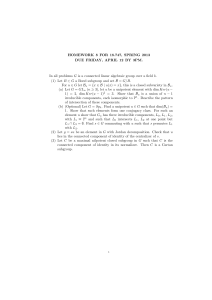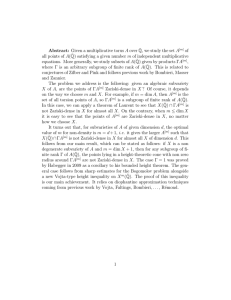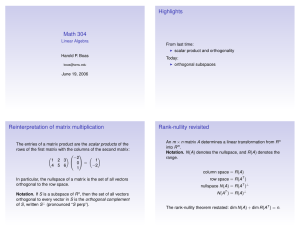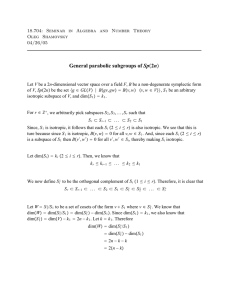COUNTING THE POINTS IN THE ORTHOGONAL GROUP
advertisement
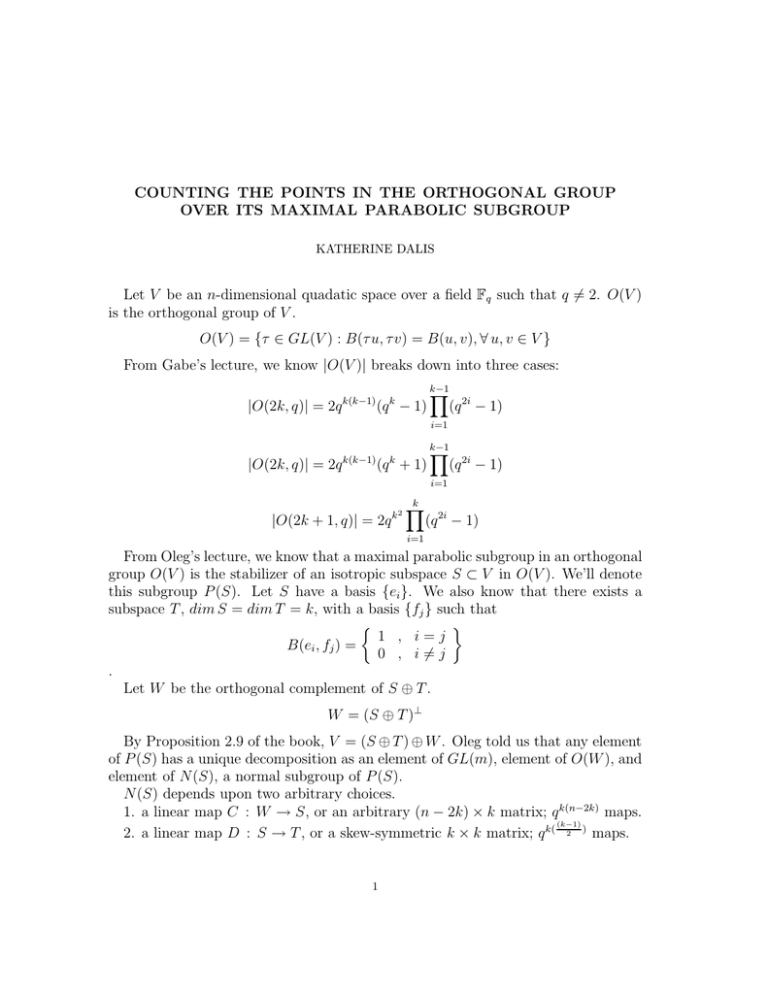
COUNTING THE POINTS IN THE ORTHOGONAL GROUP
OVER ITS MAXIMAL PARABOLIC SUBGROUP
KATHERINE DALIS
Let V be an n-dimensional quadatic space over a field Fq such that q 6= 2. O(V )
is the orthogonal group of V .
O(V ) = {τ ∈ GL(V ) : B(τ u, τ v) = B(u, v), ∀ u, v ∈ V }
From Gabe’s lecture, we know |O(V )| breaks down into three cases:
|O(2k, q)| = 2q k(k−1) (q k − 1)
k−1
Y
(q 2i − 1)
i=1
|O(2k, q)| = 2q
k(k−1)
k−1
Y
(q + 1) (q 2i − 1)
k
i=1
|O(2k + 1, q)| = 2q k
2
k
Y
(q 2i − 1)
i=1
From Oleg’s lecture, we know that a maximal parabolic subgroup in an orthogonal
group O(V ) is the stabilizer of an isotropic subspace S ⊂ V in O(V ). We’ll denote
this subgroup P (S). Let S have a basis {ei }. We also know that there exists a
subspace T , dim S = dim T = k, with a basis {fj } such that
1 , i=j
B(ei , fj ) =
0 , i 6= j
.
Let W be the orthogonal complement of S ⊕ T .
W = (S ⊕ T )⊥
By Proposition 2.9 of the book, V = (S ⊕ T ) ⊕ W . Oleg told us that any element
of P (S) has a unique decomposition as an element of GL(m), element of O(W ), and
element of N(S), a normal subgroup of P (S).
N(S) depends upon two arbitrary choices.
1. a linear map C : W → S, or an arbitrary (n − 2k) × k matrix; q k(n−2k) maps.
(k−1)
2. a linear map D : S → T , or a skew-symmetric k × k matrix; q k( 2 ) maps.
1
2
KATHERINE DALIS
P (S) ∼
= GL(k, Fq ) × O(W ) × N(S)
|P (S)| = |GL(k, Fq )| · |O(W )| · |N(S)|
|N(S)| = q k(
|GL(k, Fq )| = q
k−1
)
2
k(k−1)
2
· q k(n−2k)
(q − 1)k
k
Y
qi − 1
i=1
q−1
For now assume dim V = 2m even, and witt index(V ) = m. Then, dim W =
2m − 2k even. witt index(W ) = m − k maximal.
|O(W )| = |O(2m − 2k, q)| = 2q
(m−k)(m−k−1)
(q
m−k
− 1)
m−k−1
Y
(q 2i − 1)
i=1
In order to simplify the math n will be rewritten as 2m, dim V = n = 2m.
|P (S)| = |N(S)| · |GL(k, Fq )| · |O(W )|
= 2q
k(k−1)
2
·q k(2m−2k) ·q
k(k−1)
2
2 −m
= 2q m
Now, |O(V )/P (S)| =
·q (m−k)(m−k−1) ·(q−1)k ·(q m−k −1)
(q − 1)k (q m−k − 1)
|O(V )|
.
|P (S)|
k
m−k−1
Y
(q i − 1) Y 2i
(q −1)
(q
−
1)
i=1
i=1
m−k−1
k
Y
(q i − 1) Y 2i
(q − 1)
(q
−
1)
i=1
i=1
Remember, we assumed dim V = 2m, even.
|(OV )| = 2q
m(m−1)
m
(q − 1)
m−1
Y
(q 2i − 1)
i=1
2 −m)
Qm−1 2i
(q m − 1) i=1
(q − 1)
|O(V )|/|P (S)| =
Q
Q
m−k−1
2
2q (m −m) (q (m−k) − 1)(q − 1)k i=1 (q 2i − 1) ki=1
2q (m
(q i −1)
(q−1)
COUNTING THE POINTS IN THE ORTHOGONAL GROUP OVER ITS MAXIMAL PARABOLIC SUBGROUP
3
Qm−1 2i
(q m − 1) i=1
(q − 1)
=
Q
Q
m−k−1
(q m−k − 1)(q − 1)k i=1 (q 2i − 1) ki=1
=
= (q
m−1
= (q
(q m − 1)
i
i
i=m−k (q − 1)(q +
Q
(q m−k − 1) ki=1 (q i − 1)
+ 1) · · · (q
m−1
Qm−1
m−k
+ 1) · · · (q
+ 1)
m−k
Qm
i
i=m−k+1 (q
Qk
i
i=1 (q −
+ 1) Qk
i=1 (q
i=1
(q
m
k q
m−1
+ 1) · · · (q
m−k
1)
Qm−k i
− 1) i=1
(q − 1)
Qm−k i
1) i=1 (q − 1)
Qm
(q i
(q i −1)
(q−1)
i
− 1)
Qm−k i
− 1) i=1 (q − 1)
m
+ 1)
k q
is the q binomial coefficient.
This is the number of points in O(V )/P (S) given dim V is even, and the first
equation for |O(V )| is used. The other cases are solved similarly.
